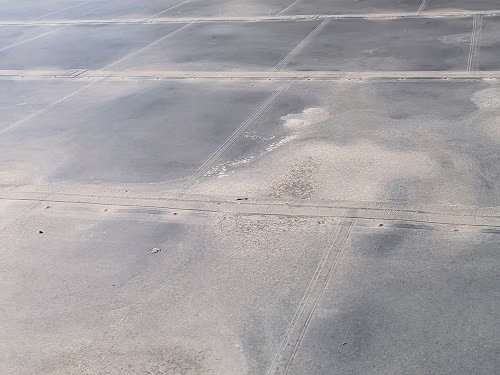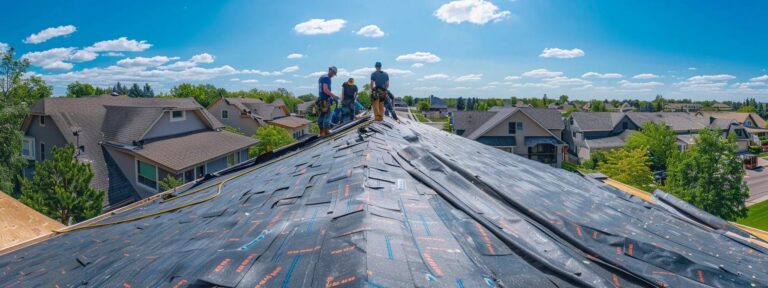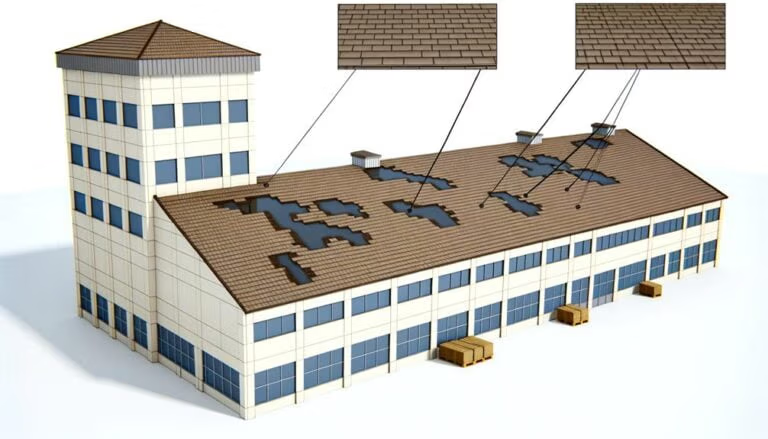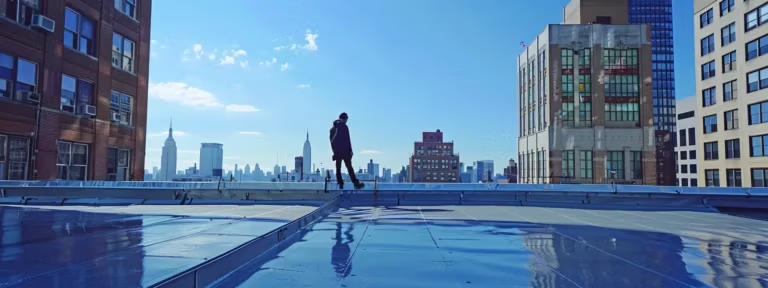Frequently Asked Questions
What are the effects of hail damage on a flat roofs lifespan?
Hail damage can significantly impact the lifespan of a flat roof. The impacts can cause cracks, punctures, and granule loss in the roof's surface, leading to leaks and accelerated deterioration. This requires prompt repair or replacement to maintain the roof's integrity and prevent further damage.
Can hail damage be prevented on a flat roof?
Hail damage on flat roofs can be prevented by using impact-resistant roofing materials, maintaining proper drainage, and installing protective measures like hail guards or specialized coatings. Regular inspections and timely repairs are also crucial.
Do all flat roofs need to be replaced after hail damage?
No, not all flat roofs need to be replaced after hail damage. The extent of damage depends on factors like hailstone size, roof material, and age. Inspection by a professional roofer can determine if repairs or replacement is necessary.
How do you fix hail damage on a flat roof?
Hail damage on a flat roof can be repaired by inspecting for punctures, cracks, or other structural issues, then patching or replacing damaged areas. Sealants may be applied to prevent further leaks. Replacing the entire roof may be necessary in severe cases.
What size hail damages roofs?
Hailstones ranging from one-inch to six inches in diameter can cause significant damage to roofs. Hailstones around two-and-a-half inches (tennis ball size) or larger can spoil the roof and cause leaks, while golf ball-sized hail can destroy exterior paint and dent cars.
Why does hail damage a roof?
Hail damages roofs due to the high impact and force of the hailstones striking the roofing materials, causing cracks, dents, and other physical damage that can lead to leaks and other issues. The extent of damage depends on factors like hailstone size, wind speed, and roofing type.
How long does it take to repair hail damage on a flat roof?
The time to repair hail damage on a flat roof can vary depending on the extent of the damage. Minor hail damage may require only patching or replacing a few shingles, which could be completed in a day. However, more extensive damage that compromises the roof's integrity may require a full roof replacement, which typically takes 2-5 days.
Can hail damage on a flat roof lead to structural issues?
Yes, hail damage on a flat roof can lead to structural issues. Hailstones can puncture the roof membrane, allowing water to seep in and potentially compromise the integrity of the roof structure over time.
What are the risks of not repairing flat roof storm damage?
Unrepaired flat roof storm damage can lead to water leaks, mold growth, structural instability, and further deterioration of the roof, potentially causing costly repairs or even roof replacement if left unaddressed.
How much does hail damage repair cost for a flat roof?
The cost of hail damage repair for a flat roof can vary greatly, depending on factors such as the extent of the damage, the roof's material, and the location. On average, repairs for a flat roof can range from $1,000 to $10,000 or more.
What does a roof with hail damage look like?
Hail damage on roofs can result in cracked, chipped, or missing shingles, punctures, and dents. The extent of damage depends on the size of the hailstones and the roofing material. Noticeable signs include roof leaks, broken windows/doors, and exterior damage like dents on siding or gutters.
What does roof damage from hail look like?
Hail damage on roofs can result in dents, cracks, or holes in shingles, tiles, metal, or other roofing materials. Damage may also include granule loss, leaks, and damage to gutters, vents, and other roof components.
Can a flat roof collapse due to storm damage?
Flat roofs can collapse due to storm damage, especially from heavy snowfall, high winds, and hail impact. The extent of the damage depends on the roof's construction, age, and the severity of the storm. Proper maintenance and preparation are crucial to prevent flat roof collapse.
What constitutes hail damage on a roof?
Hail damage on a roof can manifest in various ways, including dents, bruises, broken shingles, granule loss, cracks, and leaks. The extent of the damage depends on factors like hailstone size, wind speed, roofing material, and roof age.
What are the signs of hail damage on a roof?
The signs of hail damage on a roof include dents, cracked or missing shingles, granule loss, and leaks. Damage may also be visible on other exterior components like siding, windows, and gutters.
Can hail damage a rubber roof?
Yes, hail can damage rubber roofs. The size and impact of the hailstones can cause punctures, cracks, and other types of damage to the rubber roofing material.
Can a flat roof be replaced after severe storm damage?
Yes, a flat roof can be replaced after severe storm damage, such as from hail or high winds. The extent of the damage will determine if a full roof replacement is necessary or if repairs can be made. Proper inspection by a roofing professional is recommended to assess the extent of the damage and determine the best course of action.
How do I know if I need to replace my flat roof after hail damage?
Signs of flat roof hail damage include dents, holes, and granule loss. A professional roof inspection can determine if roof replacement is needed after hail impact.
Is hail damage common on flat roofs in my area?
Hail damage can be a significant problem for flat roofs, as they lack the steep slopes that allow hail to slide off more easily. The extent of damage will depend on factors like hailstone size, wind speed, and roof condition.
How to tell if a flat roof has hail damage?
Obvious signs of flat roof hail damage include visible dents, cracked or punctured membrane, and granule loss. A professional roof inspection is recommended to assess the full extent of any hail-related issues.
What are signs of storm damage on a flat roof?
Signs of storm damage on a flat roof include leaks, punctures, cracking, and granule loss. The extent of damage depends on factors like hailstone size, wind speed, and roofing material. Inspection by a professional is recommended to identify and address any issues.
Can a new flat roof protect against storm damage?
Yes, a properly installed flat roof can provide protection against storm damage. Flat roofs are designed to withstand high winds, heavy rain, and other severe weather conditions when installed correctly with the right materials.
Can hail damage cause leaks on a flat roof?
Yes, hail damage can cause leaks on a flat roof. The impact from hailstones can puncture the roofing material and lead to water penetration and leaks. The extent of the leak depends on the size of the hailstone and the condition of the roofing.
Can I repair flat roof storm damage myself?
Repairing flat roof storm damage yourself is generally not recommended. Storm damage often requires professional inspection and repair to ensure proper sealing and structural integrity. Attempting DIY repairs could lead to further issues down the line.
How do you identify hail damage on a flat roof?
Signs of hail damage on a flat roof include dents, cracks, and chips in the roofing material. Damage may also be seen on flashing, vents, and other roof components. A professional roof inspection can thoroughly assess the extent of hail damage.
How do you determine the extent of hail damage on a flat roof?
The extent of hail damage on a flat roof can be determined by visible signs such as dents, cracks, or punctures in the roofing material. A thorough inspection by a professional roofer is necessary to assess the full extent of the damage.
What causes flat roof damage during heavy storms?
Flat roofs are susceptible to damage during heavy storms due to ponding water, high winds, and hail impact. Pooling water can lead to leaks, while strong winds and hail can compromise the roof's integrity and cause structural damage.
What are common types of flat roof storm damage?
Common types of flat roof storm damage include punctures, tears, and ponding water from hail, heavy rain, or high winds. Roofing materials like EPDM or TPO can become cracked or detached. Roof edges and flashings may also get damaged.
How does rain affect flat roofs during storms?
Heavy rain during storms can lead to pooling on flat roofs, causing water damage if the roof is not properly sloped or has inadequate drainage. The weight of the accumulated water can also strain the roof structure.
What is the cost of repairing storm-damaged flat roofs?
The cost of repairing storm-damaged flat roofs can vary greatly depending on the extent of the damage, the roofing material, and the location. Typical costs range from $500 to $5,000 or more for larger repairs.
How long does it take to repair flat roof storm damage?
Repairing flat roof storm damage can vary greatly depending on the extent of the damage, but a typical repair project may take 1-5 days to complete, including inspection, materials procurement, and actual repair work.
What type of insurance covers hail damage on flat roofs?
Hail damage on flat roofs is typically covered under standard homeowners or commercial property insurance policies. Most basic insurance policies provide coverage for structural damages caused by hail, including roof leaks, broken windows, and damage to exterior features.
What is the process of filing a hail damage claim for a flat roof?
Here are the key steps to file a hail damage claim for a flat roof:
Inspect the roof for visible signs of hail impact, such as dents, punctures, or granule loss.
Document the damage with photographs and measurements of hailstone sizes.
Contact your insurance provider to file a claim, providing the documented evidence.
Cooperate with the insurance adjuster's inspection and assessment of the damages.
Obtain quotes from roofing contractors and submit them to the insurance company for approval.
Once approved, schedule the roof repair or replacement work with the selected contractor.
How can I prevent flat roof damage from future storms?
To prevent flat roof damage from future storms:
Install impact-resistant roofing materials like EPDM or TPO membranes.
Ensure proper drainage to avoid pooling water that can lead to leaks.
Schedule regular inspections and maintenance to identify and address issues early.
Consider adding roof reinforcements or a protective coating for added durability.
How do you stop hail damage from causing further damage to a flat roof?
To stop hail damage from causing further damage to a flat roof, quickly inspect the roof for punctures or cracks, cover any exposed areas with a tarp or sealant, and consider replacing or repairing damaged roofing materials to prevent leaks and water intrusion.
What are the consequences of ignoring flat roof storm damage?
Ignoring flat roof storm damage can lead to costly repairs, structural integrity issues, and potential safety hazards. Leaks, water intrusion, and structural deterioration may worsen over time if not addressed promptly. Regular inspections and timely repairs are crucial for maintaining a flat roof's functionality and longevity.
Are there any preventative measures against hail damage on flat roofs?
To help prevent hail damage on flat roofs, consider the following measures:
Install impact-resistant roofing materials like rubber, plastic, or metal that can withstand hail impact.
Add protective coverings like hail guards or screens over the roof surface.
Regularly inspect and maintain the roof to identify and address any potential weak spots.
Can hail damage a flat roof during a storm?
Yes, hail can damage flat roofs during storms. The size and force of the hailstones can crack, puncture, or dent flat roofing materials like single-ply membranes, built-up roofs, and modified bitumen.
Can I repair hail damage on my flat roof myself?
It is generally not recommended to attempt repairing hail damage on a flat roof yourself. Hail damage can be complex and may require a professional roofing contractor to properly assess and repair the roof. Attempting DIY repairs could lead to further damage and safety issues.
Can a flat roof be repaired after a storm?
Yes, a flat roof can typically be repaired after storm damage, depending on the extent of the damage. Minor issues like punctures or membrane separation can often be patched, while more severe damage may require a partial or full roof replacement.
What is the process for fixing flat roof storm damage?
Here are the steps to fix flat roof storm damage:
Inspect the roof for any holes, leaks, or other damage caused by the storm.
Clean the roof surface to prepare it for repair.
Patch any holes or cracks using a roofing sealant or patch material.
Reseal the roof edges and flashings to prevent future leaks.
Consider replacing the roofing membrane if the damage is extensive.
What materials are used to repair hail damage on flat roofs?
The most common materials used to repair hail damage on flat roofs are:
Modified bitumen membranes
EPDM rubber membranes
TPO (thermoplastic polyolefin) membranes
Polyurethane foam and coatings
How does storm damage affect flat roof drainage?
Storm damage can clog or damage flat roof drainage systems, leading to ponding water and potential leaks. Debris buildup in drains and gutters can prevent proper water runoff, while hail or high winds may dent or tear roofing materials.
How do I inspect a flat roof after a storm?
Here are some tips for inspecting a flat roof after a storm:
Visually inspect the roof for any visible signs of damage, such as punctures, cracks, or holes.
Check for standing water, as this can indicate drainage issues that may have been exacerbated by the storm.
Examine the flashing, seams, and other vulnerable areas for any signs of leaks or deterioration.
If you suspect significant damage, have a professional roofing contractor inspect the roof to ensure its structural integrity and identify any necessary repairs.
How do strong winds affect flat roofs in storms?
Strong winds during storms can exert significant uplift forces on flat roofs, potentially causing damage such as peeling, tearing, or even complete removal of the roofing membrane. This can lead to water intrusion and further structural damage.
How do I file a claim for storm-damaged flat roofs?
To file a claim for storm-damaged flat roofs:
Inspect the roof and document all damage with photos.
Contact your insurance provider and file a claim, providing the documentation.
Work with your insurer to assess the damage and determine the next steps for repair or replacement.
What determines hail impact on flat roofing?
The size, speed, and direction of the hailstones, as well as the roofing material, age, and any tree cover or other landscaping factors, all determine the extent of hail damage on a flat roof.
How frequently should flat roofs be inspected?
Flat roofs should be inspected at least twice a year, typically in the spring and fall, to identify and address any issues before they worsen. Regular inspections can help extend the lifespan of the roof.
What immediate steps mitigate hail roof damage?
Inspect the roof immediately after a hail storm to assess any visible damage.
Arrange for a professional roof inspection to identify any hidden or internal damage.
Repair or replace damaged shingles, tiles, or other roofing materials to prevent further deterioration.
Consider installing hail-resistant roofing materials for future protection.
What long-term effects does hail have?
Hail damage can lead to long-term issues such as roof leaks, cracked or damaged siding, destroyed landscaping, and compromised structural integrity. Over time, unrepaired hail damage can result in further deterioration and increased repair costs.
How quickly must hail damage be addressed?
Hail damage should be addressed promptly to prevent further deterioration and safety issues. Ignoring hail damage can lead to leaks, structural problems, and increased repair costs over time. Timely inspection and repairs are crucial to mitigate the impact of hail damage.
What are flat roof hail damage indicators?
Here are common signs of hail damage on flat roofs:
Cracked, chipped, or punctured slate tiles
Dents, dings, or cracks in metal components like vents, gutters, and downspouts
Granule loss, cracking, and blistering on roofing materials
How do insurance assessors identify hail damage?
Insurance assessors identify hail damage by looking for physical signs like dents, cracks, or fractures on roofing materials, siding, and other exterior components. They also consider factors like the size, pattern, and distribution of the damage to determine if it was caused by hail.
What maintenance reduces hail damage risks?
Regular roof inspections, prompt repair of any damage, and installing impact-resistant roofing materials can all help reduce the risks of hail damage to your roof.
Are flat roofs more vulnerable to hail?
Yes, flat roofs are more vulnerable to hail damage compared to sloped roofs. The flat surface provides less resistance to hailstones, leading to increased risk of punctures, cracks, and other structural issues.
What emergency repairs can owners perform?
Temporary roof patches or tarps to stop leaks
Securing loose shingles or tiles
Clearing gutters and downspouts of debris
Pruning overhanging tree branches
How can hail impact roof insulation integrity?
Hail impacts roof insulation integrity by damaging or compromising the insulation material, causing gaps that reduce its effectiveness. The size and force of hail can dislodge, compress, or tear insulation, diminishing its thermal and moisture barrier properties.
Do repair costs vary with hail size?
Yes, hail damage repair costs vary with the size of the hailstones. Larger hailstones, such as golf ball-sized or larger, typically cause more severe damage and require more extensive and costly repairs compared to smaller hailstones.
Does hail affect flat roof membrane integrity?
Yes, hail can damage flat roof membranes, causing punctures, tears, and reduced integrity. The extent of damage depends on hailstone size, wind speed, and roofing material. Regular inspections are recommended to identify and address any hail-related issues.
How does hail damage affect roof seams?
Hail impact can compromise the integrity of roof seams, leading to water leaks and accelerated deterioration. The size and velocity of hail determine the extent of damage to sealants, flashings, and other critical roof components.
Are reflective coatings resistant to hail damage?
Reflective coatings can provide some protection against hail damage, but their effectiveness depends on the coating material, thickness, and the size and velocity of the hailstones. Thicker coatings and stronger materials like elastomeric coatings are generally more resistant to hail damage.
What hail-proof roofing materials are available?
Metal roofs, such as steel or aluminum, are highly resistant to hail damage.
Impact-resistant asphalt shingles, which are designed to withstand hail strikes, are another option.
Slate and tile roofs can also be effective in protecting against hail damage.






